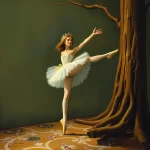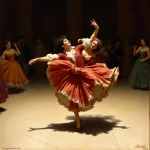Ballet: The Wooden Prince (Béla Bartók, 1917)

Introduction
Béla Bartók’s ballet, The Wooden Prince, is a captivating work that combines the talents of a renowned composer and a visionary choreographer. Premiered on May 12, 1917, at the Budapest Opera House, the ballet was choreographed by Ede Brada and composed by Bartók himself. The ballet tells a magical story of love, enchantment, and transformation, set against a backdrop of lush, evocative music and innovative choreography.
Historical Background
Creation and Development
The Wooden Prince was created during a period of significant upheaval and transformation in Europe. The early 20th century was marked by World War I, which influenced many artists and composers of the time. Bartók, a Hungarian composer, was deeply affected by the war and the changing social landscape. His work often reflected a desire to return to folk traditions and explore new musical languages.
The inspiration for The Wooden Prince came from Hungarian folklore and fairy tales. Bartók collaborated closely with choreographer Ede Brada and librettist Béla Balázs to bring this enchanting story to life. The ballet’s narrative, which revolves around a prince, a princess, and a magical wooden puppet, draws on themes of love, jealousy, and transformation.
Premiere and Reception
The ballet premiered on May 12, 1917, at the Budapest Opera House. The initial reception was mixed, with some critics praising the innovative music and choreography, while others found it challenging and unconventional. Despite the varied reactions, the ballet quickly gained recognition for its artistic merit and unique approach to storytelling through dance and music.
Notable early performances included revivals in major European cities, where the ballet continued to garner attention and acclaim. Over time, The Wooden Prince has become a staple in the repertoire of many ballet companies, celebrated for its rich musical score and imaginative choreography.
Synopsis of the Ballet
The Wooden Prince is a one-act ballet that unfolds in a series of key scenes, each contributing to the overall narrative and emotional arc of the story.
Detailed Summary
The ballet opens with a prince who falls in love with a beautiful princess. However, the princess is indifferent to his affections. In an attempt to win her love, the prince creates a wooden puppet that resembles himself. The puppet comes to life through magical means, and the princess, enchanted by the wooden prince, falls in love with it instead.
As the story progresses, the real prince faces numerous challenges and obstacles. He must navigate a forest filled with magical creatures and overcome his own feelings of jealousy and despair. Ultimately, the prince’s perseverance and genuine love for the princess lead to a transformation. The wooden puppet is revealed to be a mere illusion, and the princess recognizes the true prince’s worth. The ballet concludes with the prince and princess united in love, symbolizing the triumph of genuine emotion over superficial appearances.
Musical Composition
Composer’s Role
Béla Bartók, one of the most influential composers of the 20th century, played a pivotal role in the creation of The Wooden Prince. His contribution to the ballet’s music is profound, blending elements of Hungarian folk music with modernist techniques. Bartók’s score is characterized by its rich orchestration, complex rhythms, and evocative melodies.
Notable pieces within the score include the “Dance of the Wooden Prince” and the “Forest Scene,” both of which showcase Bartók’s ability to create vivid musical landscapes that enhance the ballet’s narrative and emotional depth.
Musical Themes and Motifs
The music of The Wooden Prince is rich with recurring themes and motifs that underscore the ballet’s central themes. One of the most prominent motifs is the “love theme,” which represents the prince’s unwavering affection for the princess. This theme recurs throughout the ballet, evolving in response to the characters’ emotional journeys.
Bartók’s use of folk-inspired melodies and rhythms adds a layer of authenticity and cultural resonance to the score. The music not only supports the narrative but also enhances the emotional impact of key scenes, drawing the audience deeper into the story.
Famous Recordings and Performances
Over the years, The Wooden Prince has been recorded and performed by numerous renowned orchestras and ballet companies. Notable recordings include those conducted by Sir Georg Solti and Pierre Boulez, both of which have been praised for their fidelity to Bartók’s original vision and their exceptional musicality.
Choreography and Dance
Choreographer’s Vision
Ede Brada, the choreographer of The Wooden Prince, brought a unique vision to the ballet. His interpretation emphasized the magical and fantastical elements of the story, using innovative dance techniques and staging to create a sense of wonder and enchantment. Brada’s choreography was characterized by fluid, expressive movements that conveyed the characters’ emotions and the narrative’s dramatic arc.
Signature Dance Numbers
One of the most iconic dance numbers in The Wooden Prince is the “Dance of the Wooden Prince,” where the wooden puppet comes to life. This scene is a showcase of technical skill and artistry, with intricate choreography that captures the puppet’s transformation from an inanimate object to a living being.
Another key dance is the “Forest Scene,” where the prince navigates a magical forest filled with mystical creatures. The choreography in this scene is dynamic and visually stunning, reflecting the prince’s journey and the challenges he faces.
Notable Interpretations
Over the years, different productions of The Wooden Prince have brought their own interpretations to the choreography. Some have emphasized the ballet’s folkloric elements, while others have focused on its modernist aspects. Notable interpretations include those by the Royal Ballet and the Hungarian National Ballet, both of which have been praised for their innovative approaches and exceptional performances.
Characters and Roles
Main Characters
- The Prince: The protagonist of the ballet, the prince is a noble and determined character who undergoes a journey of transformation and self-discovery.
- The Princess: The object of the prince’s affection, the princess is initially indifferent to his love but ultimately recognizes his true worth.
- The Wooden Prince: A magical puppet created by the prince, the wooden prince symbolizes the illusion of superficial appearances.
Supporting Characters
- The Fairy: A mystical figure who aids the prince in his journey and helps bring the wooden puppet to life.
- Forest Creatures: Various magical beings that inhabit the forest and present challenges to the prince.
Famous Dancers
Over the years, many renowned dancers have portrayed the roles in The Wooden Prince. Notable performers include Rudolf Nureyev, who brought a powerful presence to the role of the prince, and Margot Fonteyn, whose portrayal of the princess was both graceful and emotive.
Cultural and Artistic Impact
Influence on Ballet and Dance
The Wooden Prince has had a significant impact on the world of ballet and dance. Its innovative choreography and rich musical score have influenced many subsequent works and choreographers. The ballet’s blend of folkloric elements and modernist techniques has also contributed to the development of new styles and approaches in dance.
Cultural Significance
The ballet holds a special place in Hungarian cultural heritage, reflecting the country’s rich traditions and artistic innovation. It has also been adapted into various forms, including film and theater, further cementing its place in popular culture.
Legacy and Revivals
The Wooden Prince continues to be performed and celebrated today, with major revivals and reinterpretations by leading ballet companies around the world. Its enduring appeal lies in its timeless story, evocative music, and imaginative choreography.
Iconic Productions
Historic Productions
One of the most famous historical productions of The Wooden Prince was the original 1917 premiere at the Budapest Opera House. This production set the standard for future performances and featured key figures such as conductor Egisto Tango and set designer Gusztáv Oláh.
Contemporary Productions
Recent productions of The Wooden Prince have brought new interpretations and innovations to the ballet. Contemporary choreographers have explored different aspects of the story and characters, while modern set and costume designs have added fresh visual elements to the performances.
Production Design
The production design of The Wooden Prince has evolved over the years, with various interpretations of the set, costumes, and lighting. Early productions featured elaborate, fairy-tale-inspired designs, while modern productions often incorporate minimalist and abstract elements to highlight the ballet’s themes and emotions.
Critical Reception and Reviews
Initial Critical Response
At the time of its premiere, The Wooden Prince received mixed reviews from critics. Some praised Bartók’s innovative music and Brada’s imaginative choreography, while others found the ballet challenging and unconventional. Despite this, the ballet quickly gained recognition for its artistic merit and unique approach to storytelling.
Modern Reviews
Contemporary critics and audiences continue to appreciate The Wooden Prince for its rich musical score and evocative choreography. The ballet is often praised for its emotional depth and timeless themes, which resonate with modern viewers. Its enduring popularity is a testament to its significance in the world of dance.
Fun Facts and Trivia
Behind-the-Scenes Stories
One interesting anecdote from the production of The Wooden Prince involves Bartók’s meticulous attention to detail. He was known to attend rehearsals and provide input on the choreography, ensuring that the music and dance were perfectly synchronized.
Notable Performers
Famous dancers who have performed in The Wooden Prince include Rudolf Nureyev, Margot Fonteyn, and Mikhail Baryshnikov. Their interpretations of the roles have left a lasting impact on the ballet’s legacy.
Trivia
- The Wooden Prince was one of Bartók’s first major works for the stage, marking a significant milestone in his career.
- The ballet’s score incorporates elements of Hungarian folk music, reflecting Bartók’s deep interest in ethnomusicology.
- The original production featured elaborate sets and costumes designed by Gusztáv Oláh, which were praised for their visual impact.
Conclusion
Summary of the Ballet’s Importance
The Wooden Prince is a significant work in the world of ballet, combining the talents of composer Béla Bartók and choreographer Ede Brada. Its innovative music, imaginative choreography, and timeless story have left a lasting impact on the art form, influencing subsequent works and choreographers.
Final Thoughts
The Wooden Prince remains a beloved and celebrated ballet, captivating audiences with its enchanting tale and evocative music. Whether experienced through live performance or recordings, it continues to inspire and resonate with viewers around the world. For those who have yet to experience this magical work, it is highly recommended to watch a performance or listen to the score to fully appreciate its beauty and significance.
FAQ
What is the central theme of this ballet?
The central theme of The Wooden Prince is the triumph of genuine love and emotion over superficial appearances and illusions.
Who are the main characters in this ballet?
The main characters are the Prince, the Princess, and the Wooden Prince (a magical puppet created by the Prince).
What is the most famous dance number in this ballet?
The “Dance of the Wooden Prince” is one of the most famous dance numbers, showcasing the transformation of the wooden puppet into a living being.
How long does a typical performance of this ballet last?
A typical performance of The Wooden Prince lasts approximately 45-50 minutes, as it is a one-act ballet.
Are there any modern adaptations of this ballet?
Yes, there have been several modern adaptations and reinterpretations of The Wooden Prince, with contemporary choreographers bringing new perspectives to the ballet.
Why is this ballet considered important in the history of dance?
The Wooden Prince is considered important for its innovative music by Béla Bartók, imaginative choreography by Ede Brada, and its influence on subsequent works and choreographers. It represents a significant milestone in the development of modern ballet.





